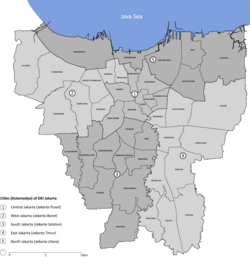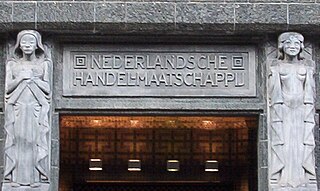
The Netherlands Trading Society was a Dutch trading and financial company, established in 1824, in The Hague by King William I to promote and develop trade, shipping and agriculture. For the next 140 years the NHM developed a large international branch network and increasingly engaged in banking operations. In 1964, it merged with Twentsche Bank to form Algemene Bank Nederland, itself a predecessor of ABN AMRO.

Taman Sari is a district (kecamatan) of West Jakarta Administrative City, Indonesia. It is the smallest district of West Jakarta (4.37 km2). It is bounded by Central Jakarta to the south and to the east, and by Pademangan in North Jakarta to the north.

Kota Tua Jakarta, officially known as Kota Tua, is a neighborhood comprising the original downtown area of Jakarta, Indonesia. It is also known as Oud Batavia, Benedenstad, or Kota Lama.
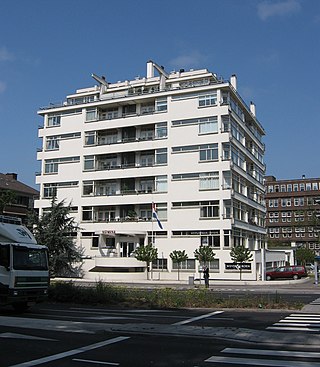
Nieuwe Zakelijkheid, translated as New Objectivity or New Pragmatism, is a Dutch period of modernist architecture that started in the 1920s and continued into the 1930s. The term is also used to denote a (brief) period in art and literature. Related to and descended from the German movement Neue Sachlichkeit, Nieuwe Zakelijkheid is characterized by angular shapes and designs that are generally free of ornamentation and decoration. The architecture is based on functional considerations and often includes open layouts that allow spaces to be used with flexibility. Sliding doors were included in some of the designs.

The Wayang Museum is a museum dedicated to Javan wayang puppetry. The museum is located in Kota Tua, Jakarta, Indonesia. It is one of several museums and galleries facing Fatahillah Square, which include the Jakarta History Museum, Fine Art and Ceramic Museum, and Kota Post Office art gallery.

Colonial buildings and structures in Jakarta include those that were constructed during the Dutch colonial period of Indonesia. The period succeeded the earlier period when Jakarta, governed by the Sultanate of Banten, were completely eradicated and replaced with a walled city of Batavia. The dominant styles of the colonial period can be divided into three periods: the Dutch Golden Age, the transitional style period, and Dutch modernism. Dutch colonial architecture in Jakarta is apparent in buildings such as houses or villas, churches, civic buildings, and offices, mostly concentrated in the administrative city of Central Jakarta and West Jakarta.
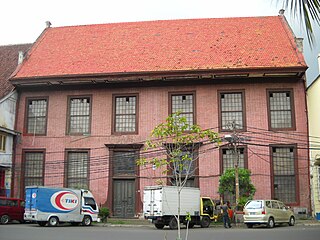
Toko Merah is a Dutch colonial landmark in Jakarta Old Town, Indonesia. Built in 1730, it is one of the oldest buildings in Jakarta. The building is located on the west side of the main canal Kali Besar. The building's red color contributes to its current name.
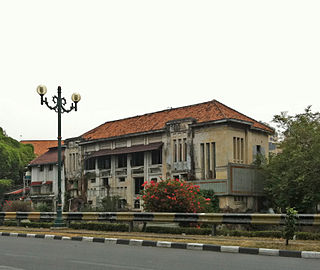
Toko Tio Tek Hong was one of the earliest modern department stores in colonial Indonesia, founded in 1902 by the prominent businessman Tio Tek Hong (1877–1965).

Pieter Adriaan Jacobus "Piet" Moojen was a Netherlands-Indies architect, painter and writer. He studied architecture and painting in Antwerp. He lived and worked in the Dutch East Indies from 1903 to 1929. He was one of the first architects to implement Modernism in the Dutch East Indies. Moojen became widely known for his work on the Dutch entry at the Paris Colonial Exposition in 1931. He was active as an architect between 1909 and 1931.
Jacobus Anthonie Meessen was a Dutch photographer who took more than 250 portraits and landscapes of the Dutch East Indies between 1864 and 1870. Born to a carpenter in Utrecht, Meessen worked in that trade in the Indies before marrying in the Netherlands in the early 1860s. He returned to the colony in 1864, intent on documenting its land and people. He worked mostly in the capital of Batavia, Java, and Padang, Sumatra; he also photographed Bangka, Belitung, Borneo, and Nias.
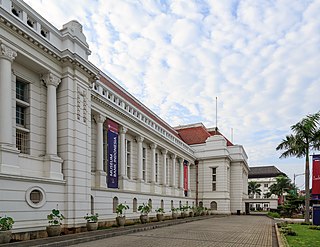
Bank Indonesia Museum, also called in English officially as BI Museum, is a bank museum located in Jakarta, Indonesia. It was founded by Bank Indonesia and opened on 21 July 2009. The museum is housed in a heritage building in Jakarta Old Town that had been the first headquarters of the Netherlands Indies gulden, the central bank of the Dutch East Indies. The bank was nationalized as Bank Indonesia in 1953, after Indonesia gained its independence. It is located next to Mandiri Museum.

New Indies Style is a modern architectural style used in the Dutch East Indies between the late 19th century through pre-World War II 20th century. New Indies Style is basically early modern (western) architecture, which applies local architectural elements such as wide eaves or prominent roof as an attempt to conform with the tropical climate of Indonesia.

The Kota Post Office is a historic building in Kota, Jakarta, Indonesia; operated by Pos Indonesia. It was designed by Ir. R. Baumgartner in 1929 as the Post- en telegraaf kantoor. The building is one of the buildings in Fatahillah Square.

Indies Empire style is an architectural style that flourished in the colonial Dutch East Indies between the middle of the 18th century and the end of the 19th century. The style is an imitation of the neoclassical Empire Style which was popular in mid-19th-century France. Conformed to the tropical setting of Indonesia, the style became known in the Dutch East Indies as the Indies Empire style.
Khouw Oen Giok Sia, later more popularly known as Oen Giok Khouw or O. G. Khouw, was a philanthropist and landowner in the Dutch East Indies. He gained notoriety for acquiring Dutch citizenship, thus breaking down the race barriers of colonial society. Today, he is best remembered for his extravagant mausoleum in Petamburan, Jakarta.

Hotel der Nederlanden was a historic hotel in Jakarta, Indonesia. Hotel der Nederlanden was one of the three grand hotels in Batavia during the last period of the colonial rule, the other being Hotel des Indes and the Grand Hotel Java. The hotel had operated for more than a century, after which it was demolished in 1969 and was replaced with the Bina Graha presidential office.

The National Archives Building is the building of the Government Museum in Jakarta, Indonesia. The building, formerly a late 18th-century private residence of Governor-General Reinier de Klerk, is part of the cultural heritage of Jakarta. The house is an archetypal Indies-Style house of the earliest period.

Johannes Martinus (Han) Groenewegen was a Dutch architect who was active in the Netherlands and the Dutch East Indies, and subsequently, Indonesia from the 1920s to the 1960s.

The Nederlandsch-Indische Escompto Maatschappij was a significant Dutch bank, founded in 1857 in Batavia, Dutch East Indies. In the first half of the 20th century, it was the smallest of the “big three” commercial banks, behind the Netherlands Trading Society and the Nederlandsch-Indische Handelsbank, that dominated the Dutch East Indies’ financial system alongside the note-issuing Bank of Java.

